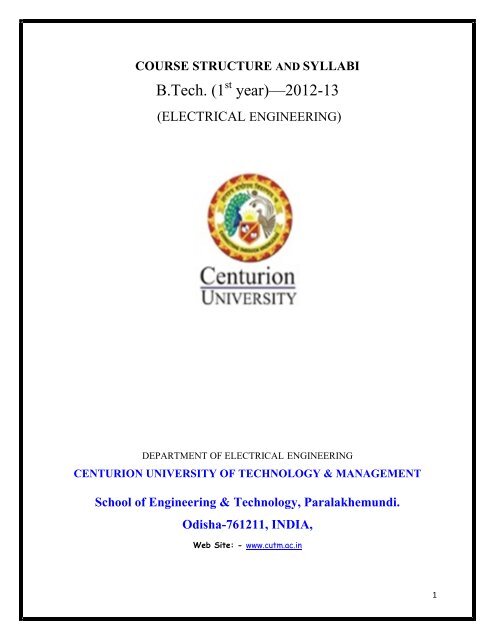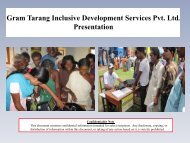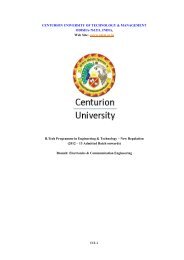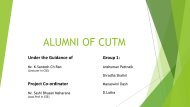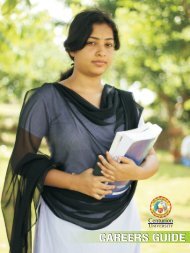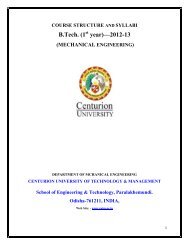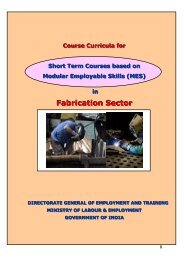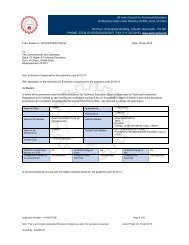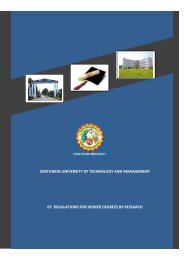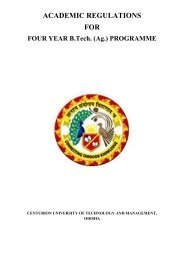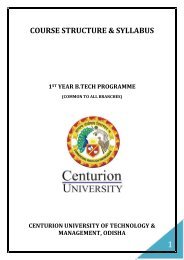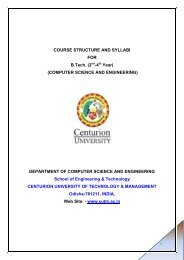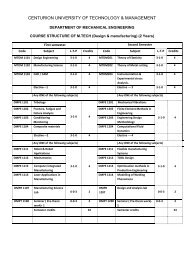1st year EE - Centurion University
1st year EE - Centurion University
1st year EE - Centurion University
- No tags were found...
Create successful ePaper yourself
Turn your PDF publications into a flip-book with our unique Google optimized e-Paper software.
COURSE STRUCTURE AND SYLLABIB.Tech. (1 st <strong>year</strong>)—2012-13(ELECTRICAL ENGIN<strong>EE</strong>RING)DEPARTMENT OF ELECTRICAL ENGIN<strong>EE</strong>RINGCENTURION UNIVERSITY OF TECHNOLOGY & MANAGEMENTSchool of Engineering & Technology, Paralakhemundi.Odisha-761211, INDIA,Web Site: - www.cutm.ac.in1
CENTURION UNIVERSITY OF TECHNOLOGY & MANAGEMENT<strong>1st</strong> SemesterTheoryDEPARTMENT OF ELECTRICAL ENGIN<strong>EE</strong>RINGELECTRICAL ENGIN<strong>EE</strong>RINGB.TECH-- 1 ST YEAR PROGRAMME -- 2012-132nd SemesterTheoryCode Subject L-T-P Credit Code Subject L-T-P CreditBTMA 1101 Mathematics-I 3-1-0 4 BTMA 1201 Mathematics-II 3-1-0 4BTCH 1204 Engineering Chemistry 3-1-0 4 BTPH 1203 Engineering Physics 3-1-0 4BTHU 1102English forCommunication2-0-0 2 BTHU 1202BTEC 1208 Electronic devices 3-1-0 4 BT<strong>EE</strong> 1108BusinessCommunicationBasic ElectricalEngineering2-0-0 23-1-0 4BTCS 1106 C in use 3-1-0 4 BTCS 1207 Data structures 3-1-0 4BLCH 1211Theory Credits 14-4-0 18 Theory Credits 14-4-0 18Practical/SessionalEngineering ChemistryLaboratory0-0-3 2 BLPH 1210Practical/SessionalEngineering PhysicsLaboratory0-0-3 2BLHU 1112 Communicative 0-0-3 2 BLHU 1212 Communicative PracticePractice lab-1lab-20-0-3 2BLEC 1217 Electronic devices lab 0-0-3 2 BL<strong>EE</strong> 1117 Basic ElectricalEngineering lab0-0-3 2BL<strong>EE</strong> 1118 Electrical Workshop 0-0-3 2 BLCS 1216 Data structures lab 0-0-3 2BLCS 1116BLHU 1111PracticeBasic Programming inCLife SkillsDevelopmentLaboratory*0-0-3 2 BLEC 12190-0-2 1* BLHU 1208Electronic circuit design& simulation labLife Skills DevelopmentLaboratory*0-0-3 20-0-2 1*Practical/Sessional Credits 0-0-17 10 Practical/Sessional Credits 0-0-17 10TOTAL SEMESTER CREDITS 28 TOTAL SEMESTER CREDITS 28TOTAL CUMULATIVE CREDITS 28 TOTAL CUMULATIVE CREDITS 56Total Contact Hours. 35 Total Contact Hours. 35*Not to be counted for CGPA computations and effective from 2013-14 admitted batch onwards.2
1 st SEMESTERBTMA 1101 MATHEMATICS-I (3-1-0)MODULE-I (15 Hours)First Order Differential Equations: Separable Equations, Homogeneous & Non- homogeneous Equations,Exact Differential Equations, Integrating Factor, Linear Differential Equations, Bernoulli Equation.MODULE-II (15 Hours)Second & Higher Order Linear Differential Equations: Linear Dependence and Independence ofSolutions, Wronskian, Constant Coefficient Homogeneous Equations, Cauchy-Euler Equation, NonhomogeneousEquations, Method of Variation of Parameter, Method of Inverse Operator, LegendreEquation.MODULE-III (20 Hours)Linear Algebra, Basic Concepts, Linear System of Equations, Solution by Gauss Elimination, Conditionsof Existence and Uniqueness of Solutions, Rank of a Matrix, Determinants and Cramer’s Rule, LinearDependence and Independence, Eigen Values and Eigen Vectors, Basis, Symmetric, Skew-Symmetricand Orthogonal Matrices, Complex Matrices, Similarity of Matrices, Diagonalization.Text Books:1) Higher Engineering Mathematics by B.V. RamanPublisher: TMHChapters : 8 (8.1 to 8.10) ; 9 (9.1 to 9.7)2) Advanced Engineering Mathematics by E. KreyszigPublisher: Johnwilley & Sons Inc-8 th EditionChapters : 6 (6.1 to 6.6) ; 7 (7.1, 7.3 to 7.5)Reference Books:1) Advanced Engineering Mathematics by P.V.O’ NeilPublisher: Thomson2) Mathematical Methods by Potter & Goldberg ; Publisher : PHI3
BTHU 1102 ENGLISH FOR COMMUNICATION (2-0-0)English is used as an important tool or catalyst in the career of students.OBJECTIVESThis is a practice-oriented, need-based, functional- communicative course designed to achieve specificlinguistic and communicative competence in order for them to acquire relevant skills and functionefficiently in a realistic working context. The student is advised to cultivate the habit of readingnewspapers, magazines, novels and books in a free, extensive manner to consolidate the skills alreadyachieved. This implies emphasis on “doing”. A more interactive process of teaching/ learning is calledfor to achieve the skills of effective communication.MODULE I: IMPORTANCE OF COMMUNICATION(8 Hours)1. Basics of Communication: Process of Communication and factors that influencecommunication – Sender, receiver, channel, code, topic, message, context, feedback,noise, filters and barriers2. Audience and Purpose3. Verbal and Non-verbal Communication4. Plain English5. Formal and Informal Style: Degrees of formality6. Guidelines for Effective Communication: Seven C’s of Communication(In this module we will discuss the importance of English language skills in a variety of contexts. Thisinteractive class will provide the students with the knowledge necessary to begin to identify anddescribe communicative events in their lives, analyze them, and make choices about meanings andresponses in appropriate and effective ways.)MODULE II: COMMUNICATIVE GRAMMAR1. Time, Tense and Aspect2. Verbs of States and Events3. Modals4. Conditionals5. Active and Passive Voice6. Statements, Questions and Responses7. Articles and Prepositions8. Concord9. Phrasal Verbs(8 Hours)(* The teaching of grammar should be treated as a diagnostic and remedial activity and integrated withcommunication practice. The areas of grammar in which errors are common should receive specialattention when selecting items for review.)4
MODULE III: THE SOUNDS OF ENGLISH(8 Hours)1. Vowels: Pure vowels and gliding vowels2. Consonants and Consonant Clusters3. Syllables and Stress Pattern in sentences4. Intonation(* This module should be taught in a simple, non-technical manner, avoiding technical terms as far aspossible.)MODULE IV: ENGLISH VOCABULARY1. One Word Substitution2. Word Formation3. Synonyms, Antonyms and Homonyms(6 Hours)(*Treatment: Word games/ clusters, cross words, puzzles, one word completions, rapid fire questions(quiz), word usage, finding words closest in meaning, practice exercises and discussions)BOOKS RECOMMENDED1. Effective Technical Communication, M. Ashraf Rizvi, TMH Publications.2. Business Communication Today, Courtland L Bovee, John V Thill & Mukesh Chaturvedi, PearsonEducation.3. Geoffrey Leech and Jan Svartvik, Longman, A communicative Grammar of English.4. J.D. O’Connor, Better English Pronunciation, Cambridge <strong>University</strong> Publication.5. An Introduction to Professional English and soft skills by B.K Das et al., Cambridge <strong>University</strong>Press6. Business Communication, Urmila Rai & S.M Rai, Himalaya Publishing House7. Business communication by Meenakshi Raman and Prakash Singh(Oxford)8. Communication Skills, Leena Sen, Prentice Hall of India, 20089. Word Power Made Easy, Norman LewisBTCH 1204 ENGIN<strong>EE</strong>RING CHEMISTRY (3-1-0)Module I [18 Hours]Structure & Bonding: Failure of Classical mechanics, Photoelectric effect, Dual nature of matter,Uncertainty principle, Schrodinger wave equation(need not be derived), interpretation of wave functions,Molecular Orbital Theory of diatomic molecules and metallic bonding. [No of lecture = 8]Phase rule: Phase, Components, Degree of freedom, Gibb’s phase rule, Phase diagram of one and twocomponent systems: H 2 O, S and Cd-Bi. [No of lecture = 5]Solid State: Crystal systems, Bravais lattices, closed packed structures, ionic solids, crystal defectsincluding Schottky and Frenkel defects. [No of lecture = 5]Module II [16 Hours]5
Reaction Kinetics & Catalysis: Rate law, Order & Molecularity, Determination of order of reaction,Kinetics of zero, 1 st and 2 nd order reactions, Collision theory, theory of absolute reaction rates, Energy ofactivation, Homogeneous and heterogeneous catalysis( a general idea). [No of lecture = 8]Electrochemistry: Electrochemical cells, EMF, Relation between EMF & free energy change of cellreactions, Electrode potentials and measurements with reference to standard hydrogen electrode,calomel electrode, determination of pH, dry cells, fuel cells and storage cells. [No of lecture = 8]Module III [16 Hours]Engineering Materials: Polymers – Types of polymerization, Plastics: Thermosetting and thermoplastics– Differences, Engineering applications of Polyethylene, PVC, polystyrene, PMMA, Nylon 6 : 6, Nylon 6,Bakelite, Teflon, Polyester. [No of lecture = 3]Ceramics: Types, properties, and applications. [No of lecture = 2]Composites: Composition, classification, role of interface, application and advantages. [No of lecture = 2]Nanomaterials: Nano materials: Basic idea, Synthesis of CNT( LASER irradiation & Electric arcdischargemethod), properties & applications of CNT, applications of other Nano materials in medicine,fuel cell, catalysis(only general idea) [No of lecture = 3]Chemical Equilibrium: Law of Mass action, relation between Kp & Kc, Expression for equilibriumconstant, Le Chatelier’s principle. [No of lecture = 3]Thermochemistry: Hess’s law of constant heat summation and its applications, Lattice energy, Born-Haber cycle. [No of lecture = 3]Text Books:1. Physical Chemistry by G.M. Barrow, 6 th edition, Tata McGraw Hill, New Delhi.2. Physical Chemistry by P.W. Atkins, 5 th /6 th edition Oxford.3. Principles of Physical Chemistry by Puri, Sharma & Pathania.4. Callister W.D., Materials Science and Engineering, John Wiley & Sons.5. Engineering Chemistry by Jain and Jain(15 th edition).6. Material Science, RaghavanReference Books:1. Physical Chemistry by Bahl & Tuli.Engineering Chemistry by Jain and Jain(15 th edition).2. Materials Science by S.K.Tripathy, Arun K.Padhy & A.K.Panda, SCITECH publication3. Vijaya M. S., Rangarajan G, Materials Science, TMH4. Rajendra V., Marikani A., Materials Science, TMH5. Engineering Chemistry by R.Gopalan, D.Venkappaya, S.Nagarajan, Vikas Publication.6. Text Book of Engineering Chemistry by S.S.Chawla, Dhanpat Rai Pub.Co.6
BLHU 1112 COMMUNICATIVE PRACTICE LAB –I (0-0-3)The language lab acts as a platform for learning, practicing and producing language skills throughinteractive lessons and communicative mode of teaching. It aims To expose the students to a variety of self- instructional, learner- friendly modes of languagelearning. To enable them to learn better pronunciation through stress on word accent, intonation, andrhythm To maintain good linguistic - through accuracy in grammar, pronunciation and vocabularyA student is required to take up five lab tests of 100 marks- three tests in spoken mode and two tests inwritten mode.The suggestive assignments in the lab are intended as learning activities to assist the student inaccomplishing the course objectives:I. FRIENDLY COMMUNICATION: 9 HOURSa) Doing Things with Words: To ask for information, help, permission; To instruct, command,request, accept, refuse, prohibit, persuadeb) Practice of Formulaic Expressions: Greetings, farewells, introductions, thanks, apologies, regrets,good wishes, congratulations, condolences, offers.c) Conversation Practice in familiar and unfamiliar situationsII. GRAMMAR AND VOCABULARYThe focus will be on the appropriate usage of language.a) Elimination of common errorsb) Editing passagesc) Word power A-Z: Easy and quick techniquesd) Vocabulary building exercises9 HOURSIII.PHONETICS AND SPOKEN ENGLISH12 HOURSStudents will be trained to find out the correct pronunciation of words with the help of adictionary /software, to enable them to monitor and correct their own pronunciation.a)Pronunciation Guidelines: Consonants and VowelsPronunciation practice (for accent neutralization), particularly of problem sounds, inisolated words as well as sentences9
) Speaking Techniques: Using correct stress patterns, developing voice qualityc) Rhythm and Intonation(Reading aloud of dialogues, speeches etc. for practice in pronunciation)BLCH 1211 ENGIN<strong>EE</strong>RING CHEMISTRY LABORATORY (0-0-3)LIST OF EXPERIMENTS01. Standardization of Potassium Permanganate by using oxalic acid or Sodium oxalate.02. Determination of ferrous ion in Mohr’s salt by Potassium Permanganate method.03. Estimation of calcium in limestone.04. Determination of total hardness of water by EDTA method.05. Estimation of sulphate ions in the given sample of water by using Turbidity meter.06. Determination of percentage of available chlorine in a sample of bleaching powder.07. Determination of dissolved Oxygen in a sample of water08. Determination of flash point & fire point of an oil by Pensky-Martens flash point apparatus09. Determination of viscosity of lubricating oil by Red-wood viscometer.10. Preparation of Bakelite.11. Preparation of Aspirin.12. Preparation of Phenolphthalein.13. Determination of amount of sodium hydroxide and sodium carbonate in mixtures.14. Determination of concentration of a colored substance by Spectrocolorimeter15. Preparation of buffer solution and determination of pH a buffer solution by using pH meter.16. To find normality of HCl by titrating it against NaOH solution conductometrically.BLEC 1217 ELECTRONIC DEVICES AND CIRCUITS LABORATORY (0-0-3)1. PN Junction diode characteristics A. Forward bias B. Reverse bias.2. Zener diode characteristics3. Transistor CB characteristics (Input and Output)4. Transistor CE characteristics (Input and Output)5. FET amplifier (Common Source)6. MOSFET Characteristics7. Rectifier with and without filters (Full wave & Half wave)8. Measurement of h parameters of transistor in CB, CE, CC configurations9.Study of DC Biasing of FET10
10. Study of DC Biasing of BJT11. Study of DC Biasing of MOSFETBL<strong>EE</strong> 1118 ELECTRICAL WORKSHOP PRACTICE (0-0-3)1. House-wiring I :-Identifying load, choosing cable-size,switch rating,fuse-ratingPreparing bill of materials,Drawing the circuit, Studying the earthing.2. 2House-wiring IIReplacing fuses,Making connections to main switch,plug-socket-switch,board,junction-box,earth-wire connection.Earth resistancemeasurement.Compliance to the requirements of a supervisor certificate.3. Study of Home-appliances,Use of 3 pin and 2 pin plug,Earthingof appliances,Study ofa multi-meter,checking connections ofIron,Fan,Mixer-Grinder.Study of Industrial wiring in the workshop (motors,weld machines, control panels,motor-control-centres, MCBs,Bimetallic-relays,Earth-connection etc)4. Fault analysis in Domestic,Industrial connections5. Fault analysis in domestic appliances.6. Study of basics of a computer and accessories7. Studying a Printed Circuit Board and practising assembly.8. Fault analysis in a PCB10. Study of a 11/.4 KV transformer substation11
BLCS 1116 BASIC PROGRAMMING IN ‘C’ LABORATORY (0-0-3)C Programming: variables and expression assignment, simple arithmetic.Loops, if else, case statements, break, continue, goto.Single and multidimensional arrays.Functions, recursions, file handling in C.Pointers, address operators, declaring pointers and operations on pointers.Address of an array, structures, pointers to structures, dynamic memory allocation.Experiment no.1a) Write a C program to find the sum of individual digits of a positive integer.b) A Fibonacci sequence is defined as follows: The first and second terms in the sequence are 0and 1. Subsequent terms are found by adding the preceding two terms in the sequence. Write aC program to generate the first n terms in the sequence.c) Write a C program to generate all the prime numbers between 1 and n, when n is a valuesupplied by the user.Experiment no.2a) Write a C program to calculate the following sum:Sum=1 - x 2 /2! + x 4 /4! – x 6 /6! + x 8 /8! – x 10 /10!b) Write a C program to find the roots of a quadratic equation.Experiment no.3a) Write C programs that use both recursive and nonrecursive functions.I. To find a factorial of given numbers.II. To find GCD (Greatest common divisor) of two given numbers.III. To solve Towers Of Hanoi problem.Experiment no.4a) Write a C program to find both the largest and smallest number in a list of integers.b) Write a C program that uses functions to perform the following:i. Addition of two matrices.ii. Multiplication of two matrices.Experiment no.5a) Write a C program that uses functions to perform the operations:I. To insert a substring into a given main string from a from a given position.II. To delete n characters from a given position in the given string.b) Write a C program to determine if the given string is palindrome or not.12
Experiment no.6a) Write a C program to construct a pyramid of numbers.b) Write a C program to count the lines, words and characters in a given text.Experiment no.7Write a program to pass a 2-D array to a function and returning the same array from function.Experiment no.8Suppose 7 names are stored in an array of pointers names[] as shown belowchar *names[]= { “ santosh”,”amol”,”prakash”,”kishore”,”rahul”,”hemant”,”nilima”};Write a program to arrange these names in alphabetical order.Experiment no.9a) Write a C program that uses functions to perform the operations:I. Reading a complex number.II. Writing a complex number.III. Addition of two complex numbers.IV. Multiplication of two complex numbers.(NOTE: represent complex number using a structure)Experiment no.10a) Write a C program which copies one file to another.b) Write a C program to reverse the first n character in a file.(NOTE: The file name and n are specified on the command line)BLHU 1111 LIFE SKILLS DEVELOPMENT LABORATORY (0-0-3) CREDITS:1Common to all Branches. Will be conducted from 1 st to 6 th Semesters for all branches. No credits addedbut the students are required to get qualified as prescribed by the T & P cell for being able to andconsidered for placement. The exercises to be carried out shall be decided as per the industry’srequirements from time to time.2 ND SEMESTER13
MODULE-I (20 Hours)BTMA 1201 MATHEMATICS-II (3-1-0)Laplace Transforms, Transforms of Derivatives and Integrals, Derivatives and Integrals of Transforms,Shifting Properties, Unit Step Function, Dirac’s Delta Function, Convolution, Inverse Transforms, Solutionto Differential Equation, Integral Equation.MODULE-II (15 Hours)Periodic Functions, Trigonometric Series, Fourier Series, Fourier Expansion of Functions of any Period,Even and Odd Functions, Half Range Expansions, Fourier Integrals, Fourier Cosine and SineTransforms.MODULE-III (15 Hours)Vector Differential Calculus: Vector Algebra, Inner Product, Vector Product, Vector & Scalar Functionsand Fields, Derivatives, Gradient of a Scalar Field, Directional Derivative, Divergence of a Vector Field,Curl of a Vector Field.Text Book:Advanced Engineering Mathematics by E.KreyszigPublisher: Johnwilley & Sons Inc-8 th EditionChapters : 5 ( 5.1 to 5.6) ; 8 (8.1 to 8.4,8.9 to 8.11 ) ; 10 (10.1 to 10.4, 10.8, 10.9)Reference Books:1) Advanced Engineering Mathematics by P.V.O’NeilPublisher: Thomson2) Higher Engineering Mathematics by B.V.RamanPublisher: TMHOBJECTIVE:BTHU 1202 BUSINESS COMMUNICATION ( 2-0-0)The course on Business Communication focuses on the basic skills required to be an effectivecommunicator. It aims at imparting the communication skills that are needed in the academic andprofessional pursuits. This is directed towards helping the students gain skills in comprehension, groupdiscussions, presentations, interviews, active listening, technical writing and the ability to managecross-cultural interactions. The focus is on the difficulty experienced by individual students, and theeffort to explore a useful strategy for self improvement. This is achieved through an amalgamation oflecture oriented approach of teaching with the task based skill oriented methodology of learning.MODULE-I: UNDERSTANDING COMMUNICATION IN BUSINESS (6 HOURS)The module is a guide to organization communication. It is directed towards enabling students todevelop the skills necessary to manage the human resources of their organization.1. General Communication and Business Communication14
2. Communication in Organizational Settings: Patterns of Communication in the Business World –Upward, Downward, Horizontal Grapevine etc, Channels of Communication- Internal andExternal, Formal and Informal3. Introduction to Cross Cultural Communication4. Strategies to Overcome Communication BarriersMODULE-II: READING AND WRITING(15 HOURS)This unit works on the competency in reading and writing skills through such tasks/activities as readingbooks, articles, magazines, novels, developing outlines, key expressions, situations, slogan writing andtheme building exercises, dialogue writing, interpreting pictures, technical writing.1. Importance of Developing Reading Skills2. Sub-Skills of Reading: Predicting Content, Skimming & Scanning, Topic sentence andsupporting details, Inferential Reading, Guessing the Meaning of Unfamiliar Words,Note Making3. Importance of Writing Skills and Principles of Effective Writing3.1 Writing Process: Pre-writing, Drafting and Re-Writing3.1.1. Paragraph Writing3.1.2. Summaries and Abstracts3.2. Business Correspondence: Writing Business Letters, E-mail Messages,Memo, Notice, Circulars, Reports, Proposals3.3. Career Communication: Writing Resume/ CV and Job Application LetterMODULE-III: LISTENING AND SPEAKING(9 HOURS)Listening is the mother of all speaking. This unit aims to achieve competence in speaking i.e., the abilityto communicate orally in clear, coherent, and persuasive language appropriate to purpose, occasion,and audience. The module focuses on developing this competency which includes acquiring poise anddeveloping control of the language through experience in making presentations to small groups, to largegroups, and through the media.1. Listening Skills: Listening Process, Hearing and Listening, Types and Barriers, EffectiveListening Strategies2. Common forms of Oral Communication in the Business World:2.1. Meetings: Organize Meetings, Preparing an Agenda, Chairing a Meeting, DraftingResolutions, Writing Minutes2.2. Persuasive Speaking: Improving Fluency and Self Expressions, Articulation, GoodPronunciation, Voice Quality2.3. Making an Oral Presentation: Planning, Preparing and Delivery2.4. Facing an Interview: Preparation, Types of Interview, Do’s and Don’ts2.5. Group Discussions: Debate and GD, Types of GD, GD Etiquette(Treatment: Developing listening and speaking skills through various activities, such as role playactivities, practicing short dialogues, JAM, group discussions, debates , speeches , listening to newsbulletins, viewing and reviewing documentaries and short films etc.)BOOKS RECOMMENDED10. Effective Technical Communication, M. Ashraf Rizvi, TMH Publications.11. Business Communication, Krizan. Merrier. Logan. Williams, Thomson12. Business Communication Today, Courtland L Bovee, John V Thill & Mukesh Chaturvedi, PearsonEducation.15
13. An Introduction to Professional English and soft skills by B.K Das et al., Cambridge <strong>University</strong>Press14. Business communication by Meenakshi Raman and Prakash Singh(Oxford)15. Business Communication, Urmila Rai & S.M Rai, Himalaya Publishing House16. Effective Business Communication, Asha Kaul, Prentice Hall17. Professional Communication, Aruna Koneru, TMHBTPH 1203 ENGIN<strong>EE</strong>RING PHYSICS (3-1-0)Module- I (18 hours)Electrical and Electronic materials: Electrical conductivity, Thermal conductivity, Free electron theory,Energy band concept of conductor, insulator & semiconductor. Intrinsic and extrinsic semiconductors,Hall Effect.Superconductor materials: Principles of superconductivity, zero resistivity, Critical magnetic field andcritical current density, Type I & II superconductors, BCS theory, Meissner effect, Isotope effect,Applications of superconductorsModule-II (16 hours)Optical materials: optical properties – scattering, refraction, reflection, transmission & absorptionLaser: Introduction, principle of Laser, stimulated and spontaneous emission, Ruby Laser, Application ofLasers.Fibre Optics: Introduction, numerical aperture, step index and graded index fibres, attenuation &dispersion mechanism in optical fibers (Qualitative only), application of optical fibres, opticalcommunication (block diagram only)Module-III (16 hours)ElectromagnetismVector calculus: gradient of scalar field, divergence, curl of vector field (only Physical significance), Gaussdivergence theorem, Stoke’s theorem, Green’s theorem (only statements)Gauss’s law of electrostatics in free space and in a medium(Only statements), electric displacement( D)magnetic Induction (B), Amperes circuital law(Only statements), displacement current, Faraday’s law ofelectromagnetic induction(Only statements).Maxwell’s electromagnetic equation in differential form and in integral form (Only statements).Electromagnetic energy density, Poynting vector, Poynting theorem, vector potential and scalar potential,electromagnetic wave equation for E and B, transverse nature of EM waves.Text Books:1. Engineering Physics by D.R. Joshi, McGraw Hill (Third reprint 2010)16
2. Engineering Physics by H.K. Malik and A.K. Singh, McGraw Hill. (First edition 2010)3. Material Science by M S Vijaya & G Rangarajan, McGraw HillReference Books:1. Material Science for Engineers by James F. Shachelford & Madanapalli K. Muralidhara, Pearson2. Callister’s Materials Science and Engineering, Wiley India (P) Ltd.3. Physics for Engineers-I: Dr. S. N. Jena & H. R. Pattnaik (First edition 2009)BT<strong>EE</strong> 1108 BASIC ELECTRICAL ENGIN<strong>EE</strong>RING (3-1-0)MODULE-1 (20 Lectures)Introduction to Electrical Engineering : Essence of electricity, Electric field; electric current, potential andpotential difference, emf, electric power, ohm’s law, basic circuit components, Ideal and PracticalSources, Source Conversion, Induced EMF, Energy Stored in Inductor & CapacitorDC Networks: Laws and Theorems applicable to DC networks (KCL & KVL, Node voltage & Mesh currentanalysis, Delta-Star & Star-Delta conversion, Superposition principle, Thevenin& Nortontheorem),Transients in R-L and R-C circuits with DC excitation. Simple problems.Magnetic Circuits: Introduction to Electromagnetism, B-H curve, Permeability, Reluctance, Solution ofsimple magnetic circuits, Hysteresis and Eddy current loss.D.C. Machines: Construction, Classification and Principle of operation of DC machines, EMF equation ofDC generator, Speed Equation of DC Motor.MODULE-2 (18 Lectures)Single-Phase AC Circuits: Single-phase EMF Generation, Waveform and Phasor Representation,Average and Effective value of sinusoids, Peak factor & Form factor, Complex Impedance and Powerusing j-operator, Power factor.Three-Phase AC Circuits: Comparison between single-phase and three-phase systems, Three-phaseEMF Generation, Line and Phase quantities in star and delta networks, Power and its measurement inthree-phase balanced circuits.Single-Phase Transformers: Construction and principle of operation, EMF Equation, Transformation ratio,Practical and Ideal transformers, Transformer losses, Brief idea on Transformer Phasor diagram andtransformer rating.MODULE-3 (12 Lectures)Induction Motors: Introduction to Three-phase and Single-phase Induction Motors, Concept of Slip, Slip-Torque characteristics (no derivations).Measuring Instruments: Introduction, PMMC Ammeters and Voltmeters with extension of range, Moving-Iron Ammeters and Voltmeters, Study of Digital Voltmeters and Multimeters, Dynamometer typeWattmeter, Energy meter.Power Systems: Brief idea about various generating plants (Thermal, Hydel, and Nuclear), Transmission,Distribution and Utilization of Electric Energy.17
Text Books:1. B.L.Theraja, A.K.Theraja “A textbook of Electrical Technology” Vol-1 & 2, S.Chand& Co. Ltd. (Vol-12005 Edition Chapter-1,2,6,7,8,10,11,12,13,19,24) (Vol-II 2005 Edition Chapter-26, 29, 30, 32, 34)Reference Books:2. Hughes, “Electrical & Electronic Technology”, Ninth Edition (Revised by J Hiley, KBrown, and I Smith), Pearson Education,.3. V.K.Mehta, “Principles of Electrical Engineering and Electronics” S.Chand& Co. Ltd.4. Rajendra Prasad, “Fundamentals of Electrical Engineering”, Prentice-Hall of India,Module 1 (18 hrs)BTCS 1207 DATA STRUCTURE USING ‘C’ (3-1-0)Development of Algorithms: Notations and Analysis. Storage structures for arrays - sparse matrices -structures and arrays of structures. Stacks and Queues: Representations and applications.Linked Lists: single linked lists - Linked stacks and queues - operations on Polynomials - Doubly LinkedLists - Circularly Linked Lists.Module 2 ( 18hrs)Binary Trees : Binary Search Trees - General Trees - Tree Traversing - Operations on Binary Trees -Expression Manipulations - Symbol Table construction - Height Balanced Trees.Module 3 (16 hrs)Graphs : Representation of Graphs - Path Matrix - BFS, DFS – Bi-connected Graphs - Topological sort -Shortest path problems. Strings - Representation - Manipulations - Pattern Matching.Sorting Techniques : Selection, Bubble, Insertion, Merge, Heap, Quick, Radix and address calculation.Linear searching - Binary Searching . Hash Table Methods.Text Books :1.Data Structures : Seymour LipschutzReference Books :1. Data Structures in C by Tanenbaum.2. Fundamentals of Data Structure by Sahany3.Data Structures, by Tremblay and Sorenson.BLHU 1112 COMMUNICATIVE PRACTICE LAB –II (0-0-3)18
The suggestive assignments in the lab are intended as learning activities to assist the student inaccomplishing the course objectives: Master Study Skills To acquire strategic competence to use both spoken & written language to use in a widerange of communication strategies Acquire Business Performance SkillsA student is required to take up five lab tests of 100 marks- three tests in written mode and two tests inspoken mode.LISTENING(6 Hrs.)Exercises on Active Listening: The whole group listens to any speech/news broadcast in English andnotes down the important points. They listen again to check their points and evaluate themselves. Thegroup then compares points to see how well they have understood the broadcast.SPEAKING1. Situational Dialogues / Role Play: Organization Communication2. Oral Presentations- Prepared and Extempore3. ‘Just a minute’ Sessions (JAM)4. Debates5. Mock Meetings6. Cracking Job Interviews: Mock Sessions7. Group Discussions on current topics(8 Hrs.)READING(8 Hrs.)Students will be given practice in reading and comprehension 6-8 passages of 100-300 words each, ontopics of General as well as professional interest. The texts will be supported by suitable exercisesdesigned to foster comprehension skills and vocabulary enrichment. Students are encouraged to readnewspapers, articles, books and novels.1. Reading Comprehension Exercises Through Tests, Writing Summary and Presenting, Note Making2. Review Presentation(Movie/ Article/ Book)3. Vocabulary Building ExercisesWRITING(8Hrs.)The Writing Lab content is designed to acquaint the students not only with the techniques of effectivewriting but also give them an insight into planning and writing documents that produce results.1. Short Paragraphs on current general and technical topics2. Creative Writing: Idea Generation3. Business Letters, Email Messages, Project Writing4. Writing Resumes and Cover Letters(* Students will be required to produce and submit by the end of second semester a 350-500 word projectreport on a topic of their choice. The project should involve data collection, analysis and reporting. Tenmarks (out of 100 marks allocated for Lab Test) will be set apart for the project.)BLPH 1210 ENGIN<strong>EE</strong>RING PHYSICS LABORATORY (0-0-3)19
Student is expected to perform twelve experiments from the list given below.1. Determination of acceleration due to gravity by Bar / Kater’s pendulum.2. Determination of thermal conductivity by Lee’s method.3. Plotting of characteristic curves of a PN junction diode.4. Plotting of characteristic curves of BJT.5. Study of Hall Effect.6. Study of resonance in LCR circuit and damping effect.7. Study of a power source- output impedance.8. Study of a Photoemission.9. Measurement of resistivity of semiconductor by four probe method and determination of bandgap.10. Study of electromagnetic damping of a compound pendulum and to find the variation of dampingcoefficient with the distance of conducting lamina.11. Determination of wavelength of LASER source by diffraction grating method.12. Measurement of attenuation and bending losses of an optical fibre.13. Measurement of numerical aperture of an optical fibre.14. Study of spatial and temporal coherence of LASER.15. Measurement of Temperature coefficient of resistance.BL<strong>EE</strong> 1117 BASIC ELECTRICAL ENGIN<strong>EE</strong>RING LABORATORY (0-0-3)List of experiments1. Connection & Measurement of power consumption of a fluorescent lamp.2. Measurement of armature & field resistances of a D.C Compound Machine.3. Connection & Testing of 1-Ø Energy Meter.4. Calculation of No-Load losses of a 1-Ø Transformer.5. Study of 1-Ø induction motor or fan motor.6. Determination of OCC (Open Circuit Characteristics) of D.C Shunt Generator.7. Starting of 3-Ø induction motor by star-delta (Υ-Δ) starter or DOL starter.8. Calculation of current, voltage, power & power factor of series RLC circuit excited by 1-Ø A.CSupply.9. Starting & Speed Control of D.C Shunt motor by (i) Field flux control method & (ii) armaturevoltage control method.10. V-I Characteristics of Incandescent lamp.20
11. Verification of Thevenin’s theorem.12. Study of DC motor using three point starter.BLCS 1216 DATA STRUCTURE USING ‘C’ LABORATORY (0-0-3)1. Write a program to search an element using sequential search.2. Write a program to search an element using binary search.3. Write a program to sort N number of element s using selection sort.4. Write a program to sort N number of elements using bubble sort.5. Write a program to implement stack operation using an array.6. Write a program to convert an infix to postfix notation using stack.7. Write a program to convert an infix to prefix notation using stack.8. Write a program to implement queue operation using array.9. Write a program to implement circular queue operation using array.10. Write a program to implement link list (creation, insertion, deletion).11. Write a program to append two link lists.12. Write a program to implement circular link list (creation, insertion, deletion).13. Write a program to implement double link list (creation, insertion, deletion).14. Write a program to construct binary tree and traverse (inorder, preorder, postorder).15. Write a program to construct a graph and traverse in DFS.16. Write a program to construct a graph and traverse in BFS.17. Write a program to sort N number of elements using quick sort.18. Write a program to sort N number of elements using merge sort.19. Write a program to sort N number of elements using heap sort.BLEC 1219 Electronic Circuit Design and Simulation Lab1. Introduction to Spice/Pspice/Matlab/Matlab Tool Box/Scilab/GNU Octave/Verilog for designingand simulation of analog, digital circuit and communication circuits2. Clipper and clamper designing and finding out the i/p and o/p waveforms .3. Half wave and full wave rectifier designing and finding out the i/p and o/p waveforms.4. RC coupled amplifier designing and finding out the i/p and o/p waveforms.21
5. Input Impedance, Output Impedance and voltage gain calculation of CE BJT amplifier using C6. Designing and simulation of comparator circuit.7. Designing and simulation of shimdit trigger circuit.8. Designing and simulation of differentiator .9. Design and simulation of an integrator circuit.10. Introduction to digital circuit and its application designing and simulation.11. Designing and simulation of counters using verilog.12. Designing and simulation mux and demux using verilog.13. Designing of half adder and full adder using verilog.14. Impedance, polarization and radiation pattern calculation of Half Wave Dipole Antenna usingMatlab/4NEC15. AM Modulation and Demodulation Study using Matlab/Scilab.BLHU 1208 LIFE SKILLS DEVELOPMENT LABORATORY (0-0-3) CREDITS:1Common to all Branches. Will be conducted from 1 st to 6 th Semesters for all branches. No creditsadded but the students are required to get qualified as prescribed by the T & P cell for being able toand considered for placement. The exercises to be carried out shall be decided as per the industry’srequirements from time to time.22


